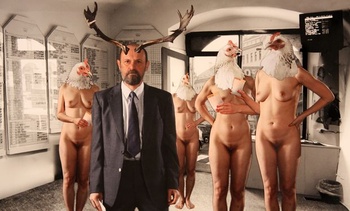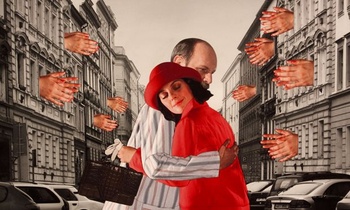A chicken-woman, a cannibalistic tree-stump child, dancing steaks, heads made of vegetables and kitchen utensils that eat each other, throw up, and start all over again: anyone who has seen Jan Švankmajer’s work is unlikely to forget it in a hurry. The Czech surrealist is coming to Brussels for an exhibition and a poetry reading and to present his “psychoanalytical comedy” Surviving Life.
His compatriot Miloš Forman once described Jan Švankmajer as a combination of Disney and Buñuel. Forgive us for falling back on that tired, much used comparison, but it is the quickest way of giving you at least some idea of his world. We could start describing his feature films – startling combinations of live action and animation such as Alice, Otesanek, and Sílení – but we don’t know where we would finish. Born in Prague in 1934, Švankmajer came to film via puppetry and graphic art. He is a member of the Czech Surrealist Group, which is the subject of an exhibition entitled “Other Air” in the Prague House.
On 10 April Švankmajer and Josef Janda will give a poetry reading at Cinema Nova, which has been showing his films for many years and is now due to screen Surviving Life, a psychoanalytical comedy in which a bureaucrat called Eugène is forever torn between his colourful daydreams about an affectionate young woman who excites him and the boring reality of his drab life in a dull little town. A psychoanalyst tries to interpret his fantasies by going back to his childhood.
How important was/is the Czech Surrealist Group for you?
Jan Švankmajer: My wife Eva and I joined the group in 1970, in the period of so-called “normalisation” that followed the Soviet invasion of Czechoslovakia. At that time the group was already banished to studios, with no opportunities to exhibit or even publish.
Our collective work was reduced at that time to “samizdat” publication and exhibitions in private studios or publishing activities in cooperation with other surrealist groups in France, Switzerland, and Sweden. In that neo-Stalinist atmosphere the group represented an oasis of free thinking and creativity, as well as of the collective exchange of values. Not to mention the moral support the group provided at the time.
Jan Svankmajer: life is but a dream

A formative experience, I gather.
Švankmajer: I consider those twenty years in the underground as crucial to my creative progress. The surrealist group was never a generational gathering. What always held it together was not the year of birth but the sharing of specific collective imaginative values. That is why the group has existed without pause from 1934 until today, across all the generations. I consider myself a surrealist of the third generation.
Is surviving your dreams easier than surviving life? Or is it the other way around? Chuang Tzu is reported to have said: “I do not know whether I was then a man dreaming I was a butterfly, or whether I am now a butterfly dreaming I am a man.”
Švankmajer: Dream and reality are like communicating vessels (André Breton); in our dreams our most secret desires come true (Sigmund Freud)….to quote the classics. From that point of view – which I completely share – it is clear that I do not make a difference between those two worlds.
Surviving Life oscillates between provocation and melancholy, openly inspired by your favourite authors, Edgar Allan Poe and Lewis Carroll; in passing, it mocks Freud and Jung’s claim to explain the world through dreams. Is psychoanalysis doomed to be comical?
Švankmajer: We can truly only make fun of things that we truly like. That does not mean that I would find psychoanalysis comic. On the contrary, psychoanalysis, for me, is one of the most amazing explanatory systems of a man and a world, just like alchemy. I base my work on both of them.
Švankmajer: I consider those twenty years in the underground as crucial to my creative progress. The surrealist group was never a generational gathering. What always held it together was not the year of birth but the sharing of specific collective imaginative values. That is why the group has existed without pause from 1934 until today, across all the generations. I consider myself a surrealist of the third generation.
Is surviving your dreams easier than surviving life? Or is it the other way around? Chuang Tzu is reported to have said: “I do not know whether I was then a man dreaming I was a butterfly, or whether I am now a butterfly dreaming I am a man.”
Švankmajer: Dream and reality are like communicating vessels (André Breton); in our dreams our most secret desires come true (Sigmund Freud)….to quote the classics. From that point of view – which I completely share – it is clear that I do not make a difference between those two worlds.
Surviving Life oscillates between provocation and melancholy, openly inspired by your favourite authors, Edgar Allan Poe and Lewis Carroll; in passing, it mocks Freud and Jung’s claim to explain the world through dreams. Is psychoanalysis doomed to be comical?
Švankmajer: We can truly only make fun of things that we truly like. That does not mean that I would find psychoanalysis comic. On the contrary, psychoanalysis, for me, is one of the most amazing explanatory systems of a man and a world, just like alchemy. I base my work on both of them.

I imagine Freud isn’t a personal hero of yours. Who is?
Švankmajer: We all grow up on certain collective ideas. We all have some pedigree, some guru. We have all been formed by crucial encounters – be it with the living or the dead. So to start from the beginning: Hieronymus Bosch, Giuseppe Arcimboldo, mannerism under Emperor Rudolf II, German Romanticism (Novalis, ETA Hoffmann, etc.), the poètes maudits (Arthur Rimbaud, Charles Baudelaire, and Comte de Lautréamont), and the surrealists (e.g. André Breton, Karel Teige, Benjamin Péret, and Vratislav Effenberger).
What do you gain by combining live action, animation, and paper-cut techniques?
Švankmajer: My films never depend on a particular technique. On the contrary – each theme itself dictates the technique with which it wants to be realised. In the film Surviving Life I used the technique of animated photography as a sort of emergency measure. We did not have enough money to make a feature film, which was what we originally intended to do with the script. I thought that with this “paper” technique we would save money on fees for actors, transport, renting space, catering, etc. When we finally did find the money for a feature film, I had become so fascinated by this “emergency method” that I didn’t want to give it up. This method was more suited to the theme of the film. It was better for creating the dream scenes: it brought into the film one more, symbolic level. And, as we know, dreams are full of symbols that psychoanalysis tries to reveal.
Do you forget about the characters you created over the years? Or is every little creature in your head?
Švankmajer: It is hard for me to say goodbye to the characters from my films. In the dream they also have a function of a symbol, an archetype, and that is why some of them have an obsessive character and you cannot get rid of them even if you want. Moreover, all my life I have been shooting one film: I see my creative work as self-therapy. It helps me to get rid of my demons, which I have accumulated over my life or which just follow me. Then it happens that some of my haunting characters (demons) pass from one film to another. It would be interesting to cut the opening and closing credits of my films, glue them together into one day-long film and watch the continuity of the story, environment, characters, actors, properties, music, and noise. Maybe then my life would be shown in a more realistic way than the one I have really lived.
Jan Švankmajer • Surviving Life: 10 > 28/4 (10/4, 20.00 + meet director), €3,50/5, Poetry reading Jan Švankmajer & Josef Janda: 10/4, 19.00, €6/7,50 Cinéma Nova, rue d’Arenbergstraat 3, Brussel/Bruxelles, 02-511.24.77, www.nova-cinema.org, Czech Surrealist Group: Other Air, 12/4 > 17/5, Prague House, avenue Palmerstonlaan 16, Brussel/Bruxelles, www.prague-house.eu
Švankmajer: We all grow up on certain collective ideas. We all have some pedigree, some guru. We have all been formed by crucial encounters – be it with the living or the dead. So to start from the beginning: Hieronymus Bosch, Giuseppe Arcimboldo, mannerism under Emperor Rudolf II, German Romanticism (Novalis, ETA Hoffmann, etc.), the poètes maudits (Arthur Rimbaud, Charles Baudelaire, and Comte de Lautréamont), and the surrealists (e.g. André Breton, Karel Teige, Benjamin Péret, and Vratislav Effenberger).
What do you gain by combining live action, animation, and paper-cut techniques?
Švankmajer: My films never depend on a particular technique. On the contrary – each theme itself dictates the technique with which it wants to be realised. In the film Surviving Life I used the technique of animated photography as a sort of emergency measure. We did not have enough money to make a feature film, which was what we originally intended to do with the script. I thought that with this “paper” technique we would save money on fees for actors, transport, renting space, catering, etc. When we finally did find the money for a feature film, I had become so fascinated by this “emergency method” that I didn’t want to give it up. This method was more suited to the theme of the film. It was better for creating the dream scenes: it brought into the film one more, symbolic level. And, as we know, dreams are full of symbols that psychoanalysis tries to reveal.
Do you forget about the characters you created over the years? Or is every little creature in your head?
Švankmajer: It is hard for me to say goodbye to the characters from my films. In the dream they also have a function of a symbol, an archetype, and that is why some of them have an obsessive character and you cannot get rid of them even if you want. Moreover, all my life I have been shooting one film: I see my creative work as self-therapy. It helps me to get rid of my demons, which I have accumulated over my life or which just follow me. Then it happens that some of my haunting characters (demons) pass from one film to another. It would be interesting to cut the opening and closing credits of my films, glue them together into one day-long film and watch the continuity of the story, environment, characters, actors, properties, music, and noise. Maybe then my life would be shown in a more realistic way than the one I have really lived.
Jan Švankmajer • Surviving Life: 10 > 28/4 (10/4, 20.00 + meet director), €3,50/5, Poetry reading Jan Švankmajer & Josef Janda: 10/4, 19.00, €6/7,50 Cinéma Nova, rue d’Arenbergstraat 3, Brussel/Bruxelles, 02-511.24.77, www.nova-cinema.org, Czech Surrealist Group: Other Air, 12/4 > 17/5, Prague House, avenue Palmerstonlaan 16, Brussel/Bruxelles, www.prague-house.eu
Fijn dat je wil reageren. Wie reageert, gaat akkoord met onze huisregels. Hoe reageren via Disqus? Een woordje uitleg.